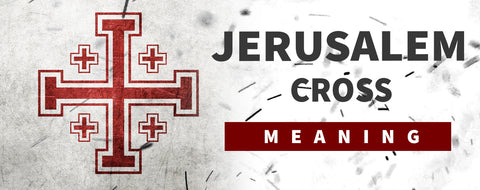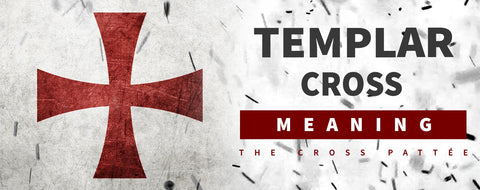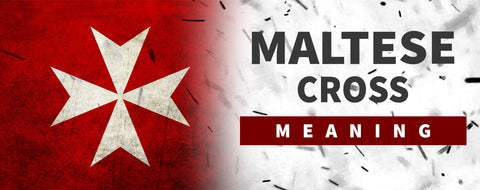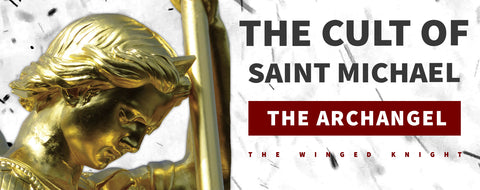
All about the Knights Templar
of reading - words
The Templar Order was created in 1119 in Jerusalem and founded on January 13, 1129, in Troyes by the knight Hugues de Payns.
If you wanted to know everything about the Templars, then you've come to the right place ! In this blog article, we will talk about various topics such as :
- The Knights Templar Uniform
- The Knights Templar Flag
- The Templar Cross
This Chivalry Order was the most prestigious military and religious order of the Middle Ages. After reading this article, you will know much more about the Templars !
The Preceptories
The territorial divisions were always called preceptories by the Knights Templar.
It was not until the 14th century that the Knights of Saint John of Jerusalem (Hospitallers of Saint John) gave them the name of commanderies.
The preceptories were as many considerable domains composed of fiefdoms and alleys, where they established fortified castles, and which they put under the guard of a brother called "preceptor", a master who had the entire administration of the land, collected the revenues of which he gave an account penny for penny, and had under his obedience the knights stationed in the house and the professed who were destined to enter the order. It seemed proper to the well-understood interests of the corporation and to the preservation of its properties to assign to a knight the possessions of a certain territory to govern and improve them, and to use the income for the benefit of all. The Knights Templar preceptory was thus a pure administration whose order charged the tutor without transferring to him anything of the right of ownership.
Property always resided in the order which, in order to make it more productive and useful, associated itself, as it was, with its members and admitted them to share with it the fruits which were to some extent those of their zeal and industrious vigilance.

At the birth of the Order, the Council immediately had at its disposal all the goods which soon multiplied in the East and in Europe. First it leased, then it deputed former religious to whom it assigned a district, a territory to administer it, to collect revenues and send them to Palestine. These treasurers, who, as we have already said, were called tutors, owed a faithful account and were allowed to retain only their modest maintenance. In these different places where the tutors made their residence, the young knights were gathered together who, under the discipline of the elders, were trained in religious and military life and took early the spirit of their profession. These were the communities or convents spread throughout Christianity that contained the most precious and dearest repository of the Order's hopes; from them came out knights who were educated in all military exercises, full of love for their state and burning with the desire to go beyond the seas to signal their courage and compete in glory with their brothers.
It was in these fortified cloisters of each commandery that the Knights Templar took refuge after their return from the East.
The Patron of the Templars
Men of all origins and conditions made up the Templar Corps at every level of the hierarchy. Different texts allow us to brush the portraits of the brother knights and sergeants.

The patron saint and protector of the Templars was Saint George. He was also the patron saint of the Teutonic Order and more generally of all Christian knights. His tomb is still venerated in Lydda in Israel.
The name George comes from the Greek Georgos "he who cultivates the land".
Saint George is traditionally represented on horseback, often white (sign of purity), slaying a dragon (a composite creature half crocodile, half lion) at his feet.
In armor, he carries a spear often broken in the hand, as well as a shield and a silver banner with a cross Gules (i.e., white with a red cross), colors that were those of the crusaders. It is an allegory of the victory of Faith over the Demon designated in Revelation as the dragon.
In medieval novels, the spear (or in some versions, a long sword) with which St. George killed the dragon was called "Ascalon," after the city of Ashkelon in the Holy Land. A blacksmith from that city is said to have fashioned it out of special steel.
Knights Templar Uniform
The recognition of the Templar Order was not only through the elaboration of a rule and a name, but also through the attribution of a particular dress code specific to the Order of the Knights Templar.
The mantle of the Templars referred to that of the Cistercian monks. Only knights, brothers of the nobility, were allowed to wear the white mantle, a symbol of purity of body and chastity. Traditionally, the white cloak or cape is the sign of both spiritual and material royalty. It is also the sign of invisibility.
But the mantle is also the symbol of metamorphoses, real or symbolicoinitiatic, which mark the rupture, following an initiation, with the profane world.
Thus, the religious, after pronouncing his three vows and taking the habit, covers himself with the cloak, symbolizing the withdrawal into himself and into God, the rupture with the world and the renunciation of his temptations and passions. The old man is transformed into a new man, having acquired new knowledge. As a result, he is also the symbol of the identification that the mantled man now assumes a dignity and a function.
The sergeants, who came from the peasantry, wore a mantle of the crust, with the cross of mules on it, without the latter having a negative connotation. The same was true for the squires.

Only common workers, noncombatants, a sort of third order, wore a black or brown coat without a cross.
It was the order that put the habit back on and it was also the order that had the power to take it back. The habit belonged to him, and in the spirit of the rule, the coat was not to be an object of vanity. It is said that if a brother asked for a more beautiful habit, he was to be given the "vilest" one. The loss of the habit was pronounced by the justice of the chapter for brothers who had seriously violated the rule. It meant a temporary or definitive dismissal from the order.
In his Bull "Vox in excelso" for the abolition of the Order, Pope Clement V indicated that he was abolishing "the said Templar Order and its state, its habit and its name," which shows the importance of the habit in the existence of the Order.
The Red Cross of the Templars
It seems that the Red Cross was granted to the Knights Templar only belatedly, in 1147, by Pope Eugene III.
He is said to have given the right to wear it on the left shoulder, on the side of the heart. The rule of order and its withdrawals did not refer to this cross. However, the papal bull "Omne datum optimum" named it twice. It can therefore be said that the Templars were already wearing the red cross in 1139.
It was therefore under the control of Robert de Craon, second master of the order, that the "cross of gules" officially became a Templar badge.
It is highly probable that the Templar cross was derived from the cross of the Order of the Holy Sepulcher, of which Hugues de Payns and his comrades-in-arms were members. This red cross was potent, flanked by four small crosses called "croisettes". (It’s a French word who mean "little crosses")
The shape of the cross of the Templars was never fixed.

The Templar iconography presented it as a simple Greek cross, anchored, floral or pattée. Whatever its shape, it indicated the Templars' belonging to Christianity and the color red was reminiscent of the blood shed by Christ. This cross also expressed the permanent vow of crusade in which the Knights Templar pledged to participate at all times.
If you would like to know more about the Templar Cross, do not hesitate to visit this article : 5 things to know about the Templar Cross.
The Templar's Portrait
In his homily (1130-1136), called De laude nouae militiae (In Praise of the New Militia), Bernard of Clairvaux presents a physical and especially moral portrait of the Knights Templar, which was opposed to that of the knights of the century: "They cut their hair short, knowing from the Apostle that it is ignominy for a man to take care of his hair. We never see them combed, rarely washed, their beards shaggy, stinking of dust, stained by the harnesses and by the heat... ».
Although contemporary of the Templars, this description was more allegorical than realistic, since Saint Bernard never went to the East.
Moreover, the Templar iconography is thin. In the rare paintings depicting them in their time, their faces, covered with a helmet, an iron hat or a camail, are not visible or only partially appear.
In article 28, the Latin rule specified that "the friars should have short hair", for practical and hygienic reasons that St. Bernard did not mention, but above all "in order to consider themselves as permanently recognizing the rule".
Moreover, "In order to respect the rule without deviating from it, they should not have any impropriety in the wearing of beards and mustaches. »
The brother chaplains were toned and beardless. Many of the miniatures depicting the Knights Templar at the stake are neither contemporary nor realistic. At that time, some had even shaved their heads to show their disengagement from the order.
Finally, the official painters of the 19th century imagined the Knights Templar in their own way, mixing idealism and romanticism, with long hair and large beards.
Templar's Everyday life
The rule of order and its withdrawals inform us in a precise manner about what was the daily life of the Templars in the West and in the East. This life was divided between times of prayer, collective life (meals, meetings), military training, accompanying and protecting pilgrims, managing household goods, trade, collecting taxes and duties due to the Order, controlling the work of the peasants on the Order's lands, diplomacy, war and fighting against the infidels.
Knights Templar Horse
An order of chivalry is worth only by the horse. Thus, the history of the Order of the Knights Templar was intimately linked to this animal.
In fact, a nobleman who was received into the order could donate his steed, a fighting horse that the squires held to the dexter, that is, to the right.
After 1140, there were many donors from the great nobility bequeathing arms and horses to the Knights Templar. To equip its army, the Order provided three horses for each of its knights, which were maintained by a squire (articles 30 & 31 of the rule). The rule specified that brothers could have more than three horses when the master authorized them to do so. This measure was probably intended to prevent the loss of the horses, so that the brothers always had three horses available.
These horses were to be harnessed in the simplest way expressing the vow of poverty. According to the rule (Article 37), "We totally forbid the brothers to have gold and silver on their bridles, stirrups and spurs. Among these horses was a steed that was trained for combat and reserved for war. The other horses were Comtois or Percheron horses, which were either Comtois or Percheron cattle. They could also be mules called "mulacious beasts". They were used to transport the knight and equipment. There was also the palefroi, more especially used for long journeys.

According to the withdrawals, the hierarchy of the order was expressed through the regulatory attribution of mounts. Withdrawals began as follows: "The master must have four animals... " indicating the importance of the subject. Moreover, the first three articles of the Master of the Order (articles 77, 78 and 79) dealt with his entourage and the care of horses. We learn that the horses were fed barley (an expensive cereal that gave the horses much more energy than a simple ration of hay) and that a farrier was in the master's entourage.
Among the master's horses was a Turcoman, an Arabian thoroughbred who was an elite war horse of great value because he was very fast.
Four horses were provided for all the high dignitaries: seneschal, blacksmiths, commander of the land and kingdom of Jerusalem, commander of the city of Jerusalem, commanders of Tripoli and Antioch, draper, commanders of the houses (commanderies), turcopolier.
Brother sergeants such as the submarshal, the gonfanonier, the cook, the farrier and the commander of the port of Acre were entitled to two horses. The other brother sergeants had only one horse. The Turcopoles, Arab soldiers in the service of the Temple order, had to provide their own horses.
It was the order's marshal who maintained all the horses and the equipment, weapons, armor, and harness without which war was not possible. He was responsible for the purchase of the horses (Article 103) and had to ensure their perfect quality. A restive horse had to be shown to him (article 154) before being dismissed from service.
The steeders were equipped with a "croce" saddle, also known as a treed saddle, which was a riding saddle for the war and which allowed the rider to be held during the charge. The commanderies in the south of France, as well as those in Castile, Aragon and Gascony, were specialized in horse breeding. The horses were then transported to the Eastern Latin States by sea. For this purpose, they were transported in the holds of the Templar naves and delivered to the caravan of the marshal of the order who supervised the distribution of the animals according to the needs. When a Knight Templar died or was sent to another state, his horses returned to the marshal service (Article 107). There are few representations of the Knights Templar. However, a mural painting of a knight of the Temple loading on his steed has been preserved. It is a fresco from the chapel of Cressac in Charente, dating from 1170 or 1180.
Knights Templar Equipment
The nobleman of the 12th and 13th centuries had to have a complete outfit made (clothing and weapons) to be knighted. This equipment, requiring mainly metals, was worth a fortune and weighed about fifty kilos. Knights templar and sergeants had to have such equipment. Body protection was provided by a shield, chain mail, and a helmet.
The helmet was without a movable visor, or took the form of an iron hat that did not protect the face. Chain mail consisted of thousands of iron rings one centimeter in diameter intertwined and sometimes riveted. This chain mail consisted of four parts: The chain mail attached to the belt with leather straps, the haubert protected the body and arms and the camail or chain mail cap. A mortar or leather cap was placed on the head to support the helmet. The hands were protected by mesh gloves called weapon gloves (article 325 of the Rule).
It should be noted that the haubert was shortened at the knee during the 13th century to be lighter. There were several methods of making chain mail. The manufacturing was long and expensive and only wealthy knights could afford it.
One of the techniques consisted in flattening the two ends of the ring and piercing them. These two ends were joined together to overlap. The only thing left to do was to join the two together by inserting a small pin into the holes, which were then hot hammered. This way the two ends were perfectly joined and difficult to separate. The rings were variable, the oldest having a diameter of 1 centimeter for a steel wire of about 2 millimeters.

Each link was taken by four others and it was thus necessary a large number of these rings to obtain one of these steel tunics.
Later, flat wire links were adopted for better protection, these links leaving less space between them, thus covering the body better. The undergarment consisted of a linen shirt and braids. The protection of the body was reinforced by the wearing of leather shoes attached by straps, and a leather gambison or gambeson. Finally, the surcoat, worn over the coat of arms, is also called a petticoat or coat of arms. It was sewn with a red cross, insignia of the order, in front and behind. It was used to recognize the Templar fighters on the battlefield as well as anywhere else.
The harness, worn around the loins, was a special belt that allowed the sword to be hung and kept the surcoat close to the body. There is also the Brogne. It was a breastplate made of skins, with iron rings sewn very close together. Appeared under the Carolingians, the Middle Ages had kept the technique.
The knight’s equipment evolved over the years. You will find in the left column some examples.
The triangular shaped shield (or shield), pointing down, was made of wood and covered with a sheet of metal or leather. It was used to protect the body, but its size was reduced during the 12th century to make it lighter and therefore more manageable.
According to Georges Bordonove, the Knights Templar received a sword, spear, mace and knife when they were received in order. Handled with two hands, the sword had a double edge and a rounded tip. Indeed, it had to be handled in such a way as to strike with size, that is to say, with the edge. It was practically used as a mass of weapons since it could not pierce chain mail. However, against an enemy who did not have this protection, the sword proved to be more effective and more elegant than the sledgehammer.
The Templar weapon mace was mainly a so-called Turkish mace with protruding points. The sword and mace were used to strike the enemy in such a way as to break his bones. The wounded then died of internal bleeding. The spear was a wooden pole with a wrought-iron point called an iron head. Each brother held three knives, one of which was a weapon knife, another "bread knife" used for eating, and a narrow-bladed pocket knife.
The Knights Templar Flag
The flag of the Knights Templar Order was called the baucent or gonfanon baucent. Baucent means bicolor and had several spellings: baussant, baucent, or balcent. It was a vertical rectangle consisting of two bands, one white and one black, cut in the upper third.
Carried high at the end of a spear, it was the rallying sign of the Templar fighters on the battlefield, protected in battle by about ten knights. The one responsible for it was called the gonfanonier. Depending on the circumstances, the gonfanonier designated a bearer who could be a squire, a turcopole soldier or a sentry. The gonfanonier rode in front and led his squadron under the command of the marshal of the order.

The gonfanon had to be visible at all times on the battlefield and that is why it was forbidden to lower it. This serious breach of the regulations could be punished by the most severe penalty, i.e., the loss of the habit which meant the dismissal of the order. According to the historian Georges Bordonove, when the main gonfanon fell because its bearer and guard had been killed, the commander of the knights would unroll an emergency standard and take over the charge. If the flag disappeared, a squadron commander would raise his black and white pennant and rally all the Templars present. If the Templar colors were no longer visible, the surviving Knights Templar had to join the banner of the Hospitallers. If the Hospitaller banner had fallen, the Templars were to join the first Christian banner they saw.
The baucent gonfanon is represented in the frescoes of the Templar Chapel of San Bevignate in Perugia, Italy. The white band is located in the upper part. It is also drawn in the "chronica majorum", the Chronicles of Matthew Paris in 1245. In this case, the white stripe is in the lower part.
The Templars as Seen by Their Enemies

The Crusaders as a whole were perceived by the Arabs as barbarians, ignorant and childish. At the beginning of the 12th century, the Knights Templar proved to be the most formidable fighters the Arabs had to face. However, outside the battlefield, they were also known for their religious tolerance. In 1140, the Emir and chronicler "Osama Ibn Mounqidh", also ambassador to the Franks, went to Jerusalem. He used to go to the ancient al-Aqsa Mosque, "the place of residence of my friends the Knights Templar". The Amir reported an anecdote during which the Knights Templar openly defended him during prayer. While the Muslims' way of praying was unknown and misunderstood by the Franks who had recently arrived in the East, the Knights Templar had this cult respected, even though it was described as unfaithful.
A few years later, in 1187, during the battle of Hattin, the Muslim leader Saladin had nearly 230 prisoners of the Knights Templar beheaded with a sword, on the spot and in his presence. Saladin's private secretary concluded by talking about his master: "What a lot of ills he cured by putting a Knight Templar to death". On the other hand, the Arab military leaders spared the imprisoned masters of the order because they knew that as soon as a master died, he was immediately replaced.






